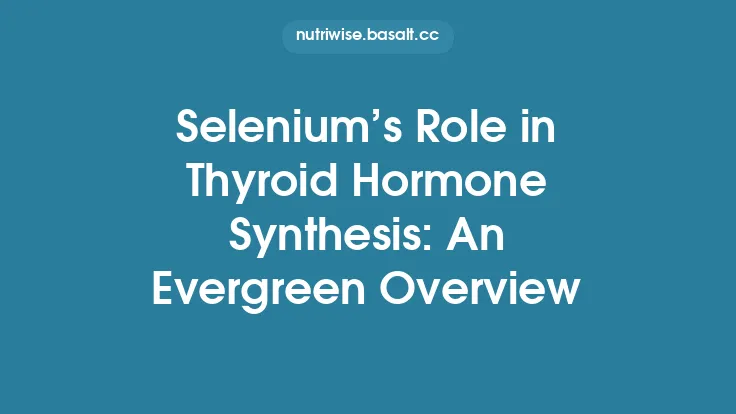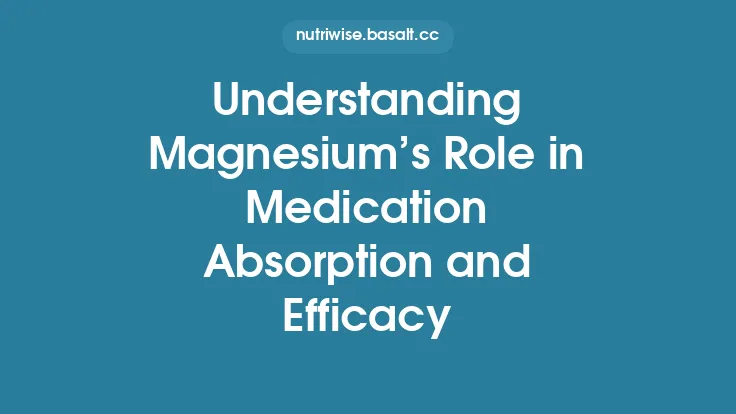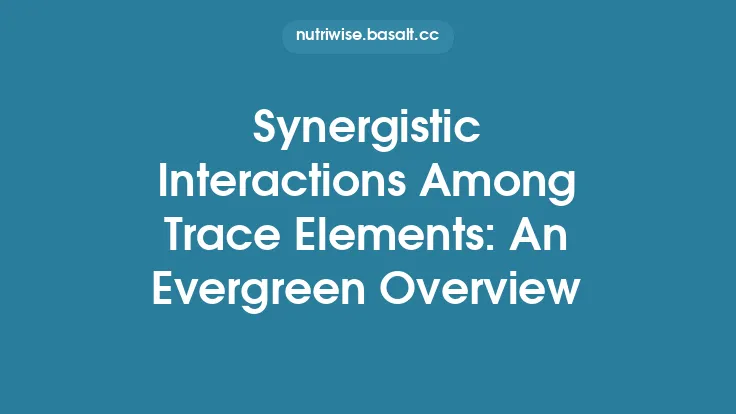Magnesium is an essential micronutrient that permeates virtually every cellular process, yet its specific contributions to muscle contraction often remain under‑appreciated. While calcium’s role as the primary trigger of contraction is widely taught, magnesium operates as a critical partner, ensuring that the contractile machinery functions with precision, efficiency, and proper timing. This overview dissects the biochemical, biophysical, and physiological dimensions of magnesium’s involvement in muscle contraction, spanning skeletal, cardiac, and smooth muscle types. By examining the molecular interactions, ion‑channel dynamics, and intracellular transport mechanisms that govern magnesium’s activity, we can appreciate how this divalent cation underpins the fundamental steps of excitation‑contraction coupling and maintains the fidelity of muscular performance.
Fundamental Biochemistry of Magnesium in Muscle Cells
Magnesium exists predominantly as the free ion Mg²⁺ in the cytosol, though the majority of cellular magnesium is bound to nucleotides, proteins, and phospholipids. In muscle fibers, the intracellular free magnesium concentration typically ranges from 0.5 to 1.0 mM, a level that is tightly regulated by a network of transporters, channels, and buffering proteins.
Key biochemical attributes that make magnesium uniquely suited for a role in contraction include:
- Charge Density and Coordination Geometry – Mg²⁺ possesses a high charge density and prefers octahedral coordination, allowing it to stabilize the negatively charged phosphate groups of ATP, ADP, and nucleic acids.
- Kinetic Stabilization of ATP – By forming a Mg‑ATP complex, magnesium reduces the activation energy required for phosphoryl transfer reactions, a prerequisite for the rapid turnover of ATP during contraction.
- Allosteric Modulation of Enzymes – Many enzymes central to muscle physiology, such as myosin ATPase, creatine kinase, and phosphofructokinase, require magnesium as a cofactor for optimal catalytic activity.
These biochemical properties set the stage for magnesium’s functional contributions throughout the contractile cycle.
Magnesium in the ATP–Energy System of Contraction
The contractile process is an energy‑intensive event, demanding the rapid hydrolysis of ATP to drive the cyclic interaction between actin and myosin. Magnesium’s involvement can be parsed into three interrelated phases:
- ATP Binding and Hydrolysis – Myosin heads bind Mg‑ATP; the magnesium ion positions the γ‑phosphate for nucleophilic attack, facilitating hydrolysis to Mg‑ADP and inorganic phosphate (Pi). This reaction releases the free energy (~‑50 kJ mol⁻¹) that powers the power stroke.
- Regeneration of ATP – Creatine kinase catalyzes the transfer of a phosphate group from phosphocreatine to ADP, forming ATP. This reaction also proceeds via a Mg‑ADP complex, underscoring magnesium’s role in rapid ATP replenishment.
- Phosphorylation of Regulatory Proteins – In smooth muscle, myosin light‑chain kinase (MLCK) phosphorylates the regulatory light chain of myosin in a Mg‑ATP‑dependent manner, a step essential for cross‑bridge formation.
Thus, magnesium is not merely a passive ion but an active participant that ensures the continuity of the high‑flux ATP cycle required for sustained contraction.
Interaction with Calcium: Balancing Excitation and Relaxation
Calcium and magnesium share many transport pathways and binding sites, leading to a dynamic antagonistic relationship that fine‑tunes muscle excitability:
- Competitive Binding at Voltage‑Gated Channels – Mg²⁺ competes with Ca²⁺ for entry through L‑type calcium channels in cardiac and smooth muscle, modulating the amplitude of calcium influx that initiates contraction.
- Regulation of the Sarcoplasmic Reticulum (SR) Calcium Pump (SERCA) – Magnesium acts as a cofactor for SERCA, the ATP‑dependent pump that sequesters calcium back into the SR during relaxation. Adequate Mg²⁺ levels enhance SERCA’s affinity for ATP, accelerating calcium reuptake and promoting timely relaxation.
- Calcium‑Magnesium Antagonism at Troponin C – While troponin C binds calcium to expose myosin‑binding sites on actin, magnesium can occupy the same low‑affinity sites, reducing the probability of premature activation and contributing to the steep calcium‑sensitivity curve observed in skeletal muscle.
Through these mechanisms, magnesium serves as a natural calcium antagonist, preventing excessive intracellular calcium accumulation and ensuring that contraction and relaxation phases are tightly coupled.
Magnesium’s Influence on the Actin‑Myosin Cross‑Bridge Cycle
The cross‑bridge cycle comprises a series of conformational changes in the myosin head that translate chemical energy into mechanical force. Magnesium impacts several discrete steps:
- Attachment (Weak Binding) – The initial weak binding of myosin to actin occurs in the presence of Mg‑ADP·Pi. Magnesium stabilizes this complex, allowing the myosin head to sense the presence of calcium‑activated troponin.
- Power Stroke (Strong Binding) – Release of Pi, facilitated by the hydrolysis of Mg‑ATP, triggers the power stroke. The presence of Mg²⁺ ensures rapid Pi release, a rate‑limiting step in force generation.
- Detachment – Binding of a new Mg‑ATP molecule to the myosin head reduces its affinity for actin, prompting detachment. The Mg‑ATP complex is essential for resetting the myosin head for the next cycle.
Experimental manipulations that alter intracellular magnesium concentrations demonstrate proportional changes in the rate of force development and the maximal shortening velocity, confirming magnesium’s integral role in the kinetic control of the cross‑bridge cycle.
Regulation of Membrane Excitability and Ion Channels
Beyond its interplay with calcium channels, magnesium directly modulates a variety of ion channels that shape the electrical landscape of muscle fibers:
- Potassium Channels (Kir and Kv) – Intracellular Mg²⁺ binds to inward‑rectifier potassium channels (Kir), influencing their conductance and contributing to the resting membrane potential.
- Sodium Channels (Nav) – Extracellular magnesium can block voltage‑gated sodium channels in a voltage‑dependent manner, reducing the likelihood of spontaneous depolarizations.
- Transient Receptor Potential (TRP) Channels – Certain TRP channels, notably TRPM7, are permeable to both Mg²⁺ and Ca²⁺, acting as conduits for magnesium influx and participating in mechanosensitive signaling pathways.
By modulating these channels, magnesium helps maintain the excitability threshold required for coordinated action potential propagation and prevents aberrant firing that could compromise contractile efficiency.
Magnesium in Cardiac Muscle Contraction
Cardiac myocytes exhibit a specialized form of excitation‑contraction coupling that relies heavily on precise calcium handling. Magnesium contributes to cardiac contractility through several avenues:
- Modulation of L‑type Calcium Current (I_Ca,L) – Mg²⁺ exerts a voltage‑dependent block of I_Ca,L, shaping the plateau phase of the cardiac action potential and influencing the amount of calcium that triggers SR release.
- Enhancement of SERCA Activity – As in skeletal muscle, magnesium is required for optimal SERCA function, facilitating rapid calcium reuptake and promoting diastolic relaxation.
- Stabilization of Myofilament Sensitivity – Mg²⁺ can alter the calcium sensitivity of troponin C in cardiac muscle, thereby fine‑tuning the force‑frequency relationship that underlies the heart’s ability to increase output during stress.
Clinical observations of altered magnesium levels in arrhythmogenic conditions underscore the ion’s importance in maintaining the delicate balance between contractile force and electrical stability in the heart.
Role in Smooth Muscle Tone
Smooth muscle contraction is governed by a calcium‑calmodulin‑MLCK pathway distinct from the troponin‑based regulation of striated muscle. Magnesium’s contributions are evident in several key steps:
- Activation of Myosin Light‑Chain Kinase (MLCK) – MLCK requires Mg‑ATP for the phosphorylation of the myosin regulatory light chain, a prerequisite for cross‑bridge formation.
- Inhibition of Myosin Light‑Chain Phosphatase (MLCP) – Elevated intracellular magnesium can indirectly suppress MLCP activity, sustaining phosphorylation and promoting tonic contraction.
- Regulation of Calcium Entry – Magnesium blocks voltage‑dependent calcium channels and certain receptor‑operated channels, modulating the calcium influx that drives MLCK activation.
These mechanisms enable magnesium to influence basal vascular tone, gastrointestinal motility, and airway smooth muscle responsiveness, highlighting its systemic relevance beyond skeletal muscle.
Cellular Transport and Homeostasis of Magnesium
Maintaining intracellular magnesium concentrations within a narrow physiological window is essential for the processes described above. The principal components of magnesium homeostasis include:
| Component | Primary Function | Representative Isoforms |
|---|---|---|
| Magnesium Transporters | Mediate influx and efflux across plasma and organelle membranes | TRPM7, MagT1, SLC41A1 |
| Na⁺/Mg²⁺ Exchanger (NME) | Extrudes Mg²⁺ in exchange for Na⁺, especially under high intracellular Mg²⁺ | SLC41A2 |
| Mitochondrial Mg²⁺ Uniporter | Facilitates Mg²⁺ uptake into mitochondria, supporting ATP synthesis | Mrs2 (yeast homolog) |
| Cytosolic Buffers | Bind free Mg²⁺, providing a reservoir and preventing rapid fluctuations | ATP, ADP, phosphocreatine, protein‑bound Mg²⁺ |
Regulation of these transport systems is responsive to hormonal cues (e.g., parathyroid hormone, aldosterone), cellular energy status, and osmotic stress. Disruption of magnesium transport can lead to altered contractile dynamics, even in the absence of overt deficiency.
Research Techniques for Studying Magnesium in Muscle Physiology
Advances in analytical methods have refined our ability to interrogate magnesium’s role at molecular and whole‑organ levels:
- Fluorescent Magnesium Indicators – Dyes such as Mag-Fura‑2 and Mag-Fluo‑4 enable real‑time imaging of intracellular Mg²⁺ transients during electrical stimulation.
- Nuclear Magnetic Resonance (⁴⁵Mg NMR) – Provides quantitative assessment of total and free magnesium pools in isolated muscle preparations.
- Patch‑Clamp Electrophysiology – Allows direct measurement of Mg²⁺‑dependent modulation of ion channel currents, particularly in cardiac myocytes.
- Genetic Manipulation of Transporters – Knockout or overexpression models of TRPM7, MagT1, and SLC41 family members elucidate the physiological consequences of altered magnesium handling.
- Isotope Tracer Studies – Use of ²⁶Mg or ²⁸Mg isotopes tracks magnesium flux across cellular compartments during contraction cycles.
These tools collectively deepen our mechanistic understanding and facilitate translation of basic findings into therapeutic contexts.
Clinical and Therapeutic Implications Beyond Deficiency
While overt magnesium deficiency is a well‑documented clinical entity, the nuanced influence of magnesium on muscle contractility extends to several therapeutic considerations:
- Anti‑arrhythmic Strategies – Intravenous magnesium is employed to stabilize cardiac electrophysiology in torsades de pointes and certain ventricular arrhythmias, leveraging its ability to modulate calcium influx and membrane excitability.
- Management of Hypertensive Vascular Tone – Pharmacologic agents that enhance intracellular magnesium (e.g., magnesium‑sparing diuretics) can attenuate excessive smooth‑muscle contraction, contributing to blood pressure control.
- Peri‑operative Muscle Relaxation – Magnesium’s antagonism of calcium channels can potentiate the effects of neuromuscular blocking agents, allowing lower dosages and reducing postoperative residual blockade.
- Heart Failure Therapeutics – Modulating magnesium handling may improve diastolic relaxation by enhancing SERCA activity and reducing calcium overload in failing myocardium.
These applications illustrate how a detailed grasp of magnesium’s contractile role informs clinical decision‑making beyond the simple correction of deficiency.
Future Directions and Emerging Insights
Research on magnesium in muscle physiology is poised to expand along several promising avenues:
- Structural Biology of Mg‑ATP Complexes – High‑resolution cryo‑EM studies of myosin heads bound to Mg‑ATP aim to visualize the precise coordination geometry that dictates hydrolysis rates.
- Magnesium‑Sensitive Signaling Networks – Systems‑biology approaches are uncovering how magnesium flux integrates with calcium‑dependent kinases, phosphatases, and metabolic sensors to orchestrate contractile adaptation.
- Targeted Modulation of Magnesium Transporters – Small‑molecule modulators of TRPM7 and MagT1 are being screened for their capacity to fine‑tune intracellular magnesium without systemic side effects.
- Cross‑Talk with Other Divalent Cations – Investigations into the interplay between magnesium, zinc, and manganese in muscle cells may reveal cooperative or competitive mechanisms that influence contractile efficiency.
- Personalized Magnesium Homeostasis – Genomic profiling of magnesium transporter polymorphisms could enable individualized strategies for optimizing muscle performance in athletes and patients with cardiac or vascular disorders.
Continued interdisciplinary collaboration—bridging biochemistry, electrophysiology, pharmacology, and clinical medicine—will be essential to translate these insights into tangible benefits for muscle health.
In sum, magnesium is far more than a supporting actor in the drama of muscle contraction. Its capacity to stabilize ATP, regulate calcium dynamics, modulate ion channels, and directly influence the actin‑myosin cross‑bridge cycle positions it as a central orchestrator of muscular function. Recognizing and harnessing this multifaceted role enriches our understanding of muscle physiology and opens pathways for innovative therapeutic interventions that respect the delicate balance of intracellular magnesium.





